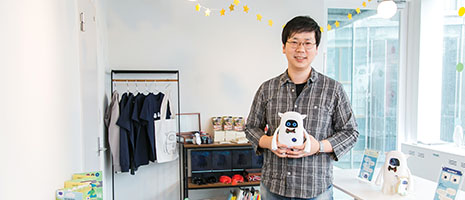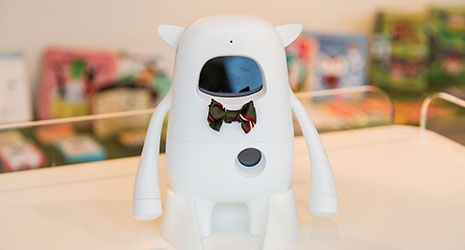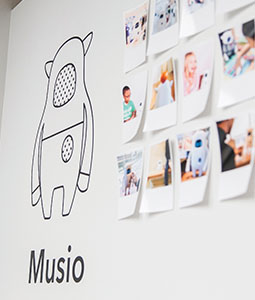Home > Highlighting JAPAN > Highlighting Japan June 2018 > My Way
Highlighting JAPAN


Supporting English Learning Accessibility in Japan Using Robots
U.S. startup AKA’s little robot, Musio, supports English learning. Brian Lee, the Chief Strategy Officer, reveals how AKA and Musio successfully entered the Japanese market.
Musio is a white, round-bodied, two-headed robot about thirty centimeters tall with charming eyes. Musio speaks perfect English and is an expert English tutor, something that is in high demand in Japan. AKA Intelligence, the U.S. startup that created Musio, was launched in 2009 to develop artificial intelligence communication engines and robots. The company’s aim is to create a world where humans and robots become friends.
When AKA sought funding for robot development through a U.S. crowdfunding website, “the largest number of investors were Japanese, although the site was little known in Japan,” says chief strategy officer Brian Lee at the company’s Japanese subsidiary. That was a compelling reason for pursuing business here since 2015.
Now a Tokyo resident who speaks fluent Japanese, Lee had no contact with anyone Japanese while growing up in his native South Korea until he graduated high school. However, a desire to learn something different from other people and in a new environment—and a Korea-Japan government exchange program—brought him to Japan in 2005. After studying engineering science at Kyoto University, he worked at a Japanese consulting company and the Tokyo office of a U.S. company until his search for “an interesting and enjoyable job” brought him to AKA.
While drawing up a business model in the early days, AKA came up with the idea of popularizing English-language education robots in Japan. Likely due to the influence of animation, the Japanese have a powerful affinity for robots, and several types of household robots already exist. To Lee, who grew up watching Astro Boy, Doraemon and other Japanese anime imported to Korea, Japan appeared to have the world’s largest robot market. And unlike China and Korea, whose English-language education markets are mature, teaching people English is still a growth market in Japan thanks to factors such as university entrance examination reform and the introduction of English lessons at public elementary schools.
Central government and Tokyo Metropolitan Government policies designed to attract and support foreign businesses helped AKA enter the Japanese market, and they were also able to establish tie-ups with several major Japanese companies.
“Musio’s English-language education talent is a tangible reason for users to buy robots,” Lee explains, “so major companies seeking an AI project could forecast its monetization in concrete terms.” AKA’s encounters with Japanese companies that were interested in AI and did business speedily provided great impetus for developing the company’s business in Japan. In collaboration with a manufacturer in Niigata, Lee’s dream of developing a ‘Made in Japan robot’ took shape.
Providing continual, low-cost contact with English, Musio is currently gaining fans among both young and senior users, and is also being adopted for school lessons. Lee is keen to increase the educational content and also make a robot specifically geared for seniors. “Musio’s English app has a user score ranking, with seniors taking all the top spots,” he says. “One user told us, ‘I feel like I’m talking normally with a person. I even quarreled with Musio.’ We were surprised at how far AI could go.”
Conversation and language learning, incidentally, are linked to the prevention of dementia. Lee’s ideas from his love of Japan’s robot anime may yet enter the real world, and in Japan’s aging society, the day may arrive when we coexist with robots, with “one per family.”
© 2009 Cabinet Office, Government of Japan







